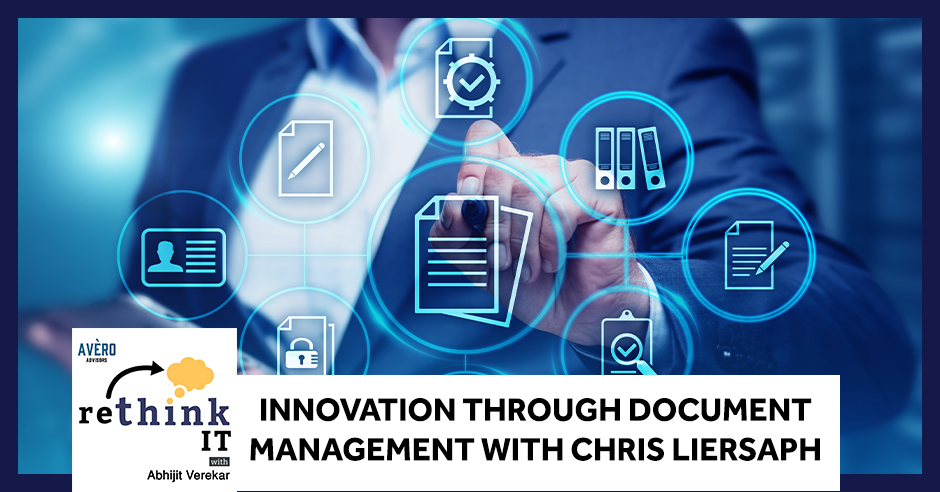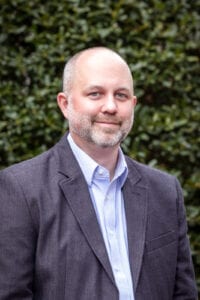Innovation through Document Management

In this episode, Abhijit Verekar invites Christopher Liersaph from Union County, NC, about how he transitioned from being a document management domain specialist to becoming an IT director-level generalist. Christopher touches on the skills required in this move and what he thinks about innovation and applying that to leadership in technology. He also shares how they are doing during this pandemic, what strategies they are implementing, and what are the key things they are learning from this time to reinvestigate the pillars of their organization and improve them. Follow along to this conversation as Christopher further talks about transferring a business vision to your tech team, envisioning a smart county, utilizing social media for marketing, and more.
—
Listen to the podcast here:
Innovation through Document Management
My guest is Christopher Liersaph. He is the Acting Director of Information Systems at Union County, North Carolina. Chris, welcome to the show.
Thank you for having me.
Chris, you and I have known each other for a while now. In many conversations, we’ve found things that we are passionate about and common. I’ve enjoyed talking to you about your career and your transition from a document management domain specialist to an IT director-level generalist. Talk to us a little bit about your career where you started and what’s your story?
I’ve been with Union County since 2013. Before that, I was in the private sector and primarily dealt with document imaging, workflows, and business process. I came on with Union County in 2013 when they create a document imaging project that was initially based through Health and Human Services. The state-mandated that we move away from paper over to a digital collection of their case records and stuff. My initial position was to help get that off the ground. From there transitioned that project over to a countywide document imaging business process set up. Starting in about 2017, 2018, because as IT becomes more integrated into different departments, I started noticing there would be other things outside of document imaging that would be important for business processes and start moving more toward IT generalist about seeing what software works best for which departments. After our director retired, I was promoted to assistant director and then I’m the interim director, acting director until that position is filled.

Document Management Specialist: Not everything needs to be in a repository or have metadata and a template assigned to it.
Going back to the beginning of your career, how did you even get into document imaging?
I was a paralegal in the early 2000s for a law firm called McGuireWoods. Our projects were mainly the commercial buying of large skyscrapers. At the time hundreds of millions of dollars of projects for buildings and there would be these huge binders of all the legal documents and everything that was collected to it. I started in that position and then after September 11th, the market for sky rises, and stuff like that dropped. I ended up switching over to a company called Patterson Pope. I was talking with them and they were like, “We found this project for scanning.” There wasn’t a lot of document retention paralegal work at the time. I switched over at that point because I was still finishing up college. They started that program and I guess it’s about the fall of 2002. What they would do is this company would go out and then they would find jobs where people like doctors’ offices, hospitals, and stuff. We have all this paper. We don’t know what we’re doing with it. We would come in, organize it, scan it. At the time, we were using OnBase, which was the main product. I started from there.
Document management is a pretty misunderstood domain. A lot of clients, a lot of prospects come up to us and say, “We want to do a scanning project.” My response to them is “You want to do a document management project?” You can easily scan it. How you find it is where the project takes shape. How have you dealt with educating your internal colleagues or customer departments on the whole document imaging and the complexities of it?
It is challenging because you can have someone have an office of twenty years of paper and you scan all that paper. If it’s not in any type of structure, it’s not going to do anyone any good. A lot of times what I try to do is start with why do you have the documents, to begin with? Are they actual items? Are they for reference? Sometimes it’s part of a business. You have unstructured documents. I usually try to explain that not everything needs to be in a repository or have metadata and a template assigned to it. What you’re looking for is what are pieces of information that you need to use to move your project going forward and how do we keep track of it? How do people become aware of it and build a process around structured documents? Everyone still has their junk folder, like they have a junk drawer where you shove stuff into. Trying to get more people to think, “Why do I have that, to begin with? Maybe I can get rid of it and then focus on structured documents.”
Being a director CIO level requires as many soft skills as hard technical components. Share on XEspecially document management projects, you can implement a system but you’re always tweaking it. It’s either because retention laws change or you’re doing processes better.
A lot of times, just because of how quickly technology changes now, any one system could change that every 3 to 5 years. The actual records that you want to keep, you still need to be able to access them. You want something that’s homogenous across the spectrum so that you don’t have to worry about “I saved it in this type of a file set and it doesn’t exist anymore. Now I don’t know how to get to it.” Having something that is structured and being easily accessible, that’s one of the main things we also run up against is how do we get information to our customers, and then also internally as well.
You mentioned at Union County, you’ve implemented a large document management system. How did you start and how did you know where to start? It was Health and Human Services, the only department you were supposed to do at the time?
Yes. It was mandated from the state that they were going to start with HHS. I started having meetings with the different directors of different departments and there was a need for veteran services. We scanned and transitioned all of those files over. Our personnel files, all of the employee files dating back many years ago are in a storage facility like on the third floor. Scanning all of those documents, their folder structure was just that. You have a folder for AV. When you started all the way through your retirement, it’s one chunk of paper and breaking that out between your acknowledgments, your performance reviews. We worked with tax quite a bit at the very beginning, moving deeds and parcels, plans, and stuff over into documented because all of that was still paper at the time. It expanded from there.
Did the county have a system or did you have to implement something at the time?
They did an RFP for HHS and it was for Laserfiche with a Northwoods compass overlay, which used LF as the repository and then CoMPAS sits on top of that. Since we had that huge project already there, we then used LF as our basis for the rest of the department.
I’m sure when you pick the product and right before it was implemented and as you’re leading this, the first thing you probably did was come up with a document structure and a taxonomy. Step number one is to map out how you want to store your documents and the last step is the actual scanning process. Walk us through a little bit about that.

Document Management Specialist: In the accounting space, there’s only so much money that you need to utilize well. You don’t have the luxury of making really big mistakes because if you lose confidence, you’re out the door.
You have that first have the buy-in at the management level and then you get the buy-in from that as you said. They agree to like, “We’re going to figure this out.” When I realized what was good was to get down to the staff that is the one moving the paper from one room to the next, up the elevator, down the elevator. I would shadow them for a couple of business days to learn their process and their job. Having the knowledge of what we could do electronically, start working with them about like, “How can I make your job easier if you were searching for this? What would you search for? If you use terms like that, you come into a room and someone says, “This is Christopher Liersaph. He’s here to tell you what your taxonomy is,” everyone shuts down. They’re like, “You don’t know anything about public health records.”
I tried to at least start at that level and build relationships at the ground level. They knew what we were trying to build was going to make their life easier. As you work your way back up to management and say, “This is your taxonomy. This is your disposition schedule.” If you utilize this system, a lot of times, we can incorporate email notifications, direct approvals, moving up digital signatures,” and then people start seeing an ROI on that side of it. It took probably close to 1 to 1.5 years to get people to buy into it.
It’s been a roaring success, the deployment of LF at Union County. Were you a part of the IT Department?
Yes.
Did you have visibility into other IT elements because of your role as the lead on the document management deployment?
Yes. I was also very lucky that at the time my manager allowed me a lot of control and creativity in how we implemented LF and how we used it. Laserfiche is so expansive for instance, they have web access where you can access documents through a browser, which means I had to learn IIS and web components. The file shares for LF, basic server components for that. Everything is SQL backend. That gave me an opportunity to learn SQL as a language and then how to incorporate all of that. Basic PowerShell workflows of how to move things through people and have automation. It allowed me to see lots of different pieces on the software side of things.
HHS, then you deploy some tax stuff. You have to move through departments within the county. At what point did you go from being the Laserfiche Document Management Expert to someone in IT management? How did that transition happen?
The previous director, Carl Lucas, was here for 30 years. When he started, it was a one-man show. As you are aware, we were a very lean department. Even by the time I came on, when I was new then the next newest employee had already been here 7 to 8 years. It was a very tight-knit group. I got a lot of buy-in from a lot of departments because of my ability to understand their business processes. Where I was able to start working with them and then realized that they would be happy with the LF implementation, but then say not happy about another aspect or something like that. I would try to help come up with solutions across the board when it comes to IT. That allowed me to move more into a managerial role. In my previous space, I had a managerial role of about 50 employees. We were three shifts. They were mainly semi-skilled labor like scanners, pulling staples. I had some experience from that side of things. It was a natural transition.
Keep your eye toward innovation so you can make improvements and streamline what you can build-out. Share on XIt sounds like the real value in changing your trajectory from document management only to management was your deep understanding of how different departments work. It feeds into my theory of you can be a strong, technically talented IT professional. That doesn’t mean you always can become an IT director to CIO type of person. What are your thoughts?
I agree with that a lot. Especially at the director CIO level, there is a component of as much soft skills as hard technical components. By the time you’re at that level anyway, you would have to be awake 24/7 to be able to deep dive into all components of an IT department. You have to be able to rely on your staff, rely on trends of what’s happening now, like software as a service, infrastructure as a service because as things grow and as IT becomes more incorporated within departments, there’s too much that you couldn’t even know so much of the pool. At this level, it’s better to have an understanding of the entire surface.
Also as you said, not just what’s going on in the market but your own core beliefs around innovation. It’s not always about the systems, the software, or the hardware. How do you think about innovation and how do you apply that to leadership in technology?
A good example would be with LF. When I first started, they had one document in there and now we have close to two million documents, 160 workflow processes over the last few years. In order to do that was trying to keep your eye toward innovation and how you can make improvements, what you can streamline, what you can build-out. As we move forward, especially with what happened with the pandemic, how you can change work from being more of a mindset and not a space and using what already exists in the Microsoft environment like RDS, getting away from like VPNs, and moving more toward direct access. Trying to make it so that people have the tools at their disposal so they can do their job. The way we’re all connected now through our phones, tablets, and stuff allowed people the opportunity to work away from an office space.
That’s a great example because things change overnight in 2020. With that, also came a glut of options available when the pandemic first started and we knew that the outcome needs to be that people need to work from home or anywhere. How did you cut through the noise that was coming at you in terms of options available to make that happen?
There was a lot of noise at the very beginning and the actual stress points of how’s this going to work? It has to be reliable because if it’s not reliable, people lose confidence in it immediately. You’re selling an uphill battle at that point. The first thing that we did as a group was to go out and look at what is sustainable for working remotely that’s already the key players on market. We looked at things like Cisco Nutanix. We decided because terminal services had been around since the ‘80s. It’s been rebranded a bunch of different times. There’s a reason why it’s been around for so long as it has. When they rebranded it as remote desktop services, we had the infrastructure already, which means we didn’t have to go through any type of procurement process and new vendors.
We were able to use the components we have in our Microsoft EA agreement to stand those servers up. We were lucky enough that we had good technicians that were able to get a proof of concept up fast. There was some learning curve on how to get into certain things. The email looked a little different, small cosmetic things. We were lucky in the fact that a lot of what we do and with LF too, having things already in a repository that we could get to remotely. If you can get to your working documents and if you can get to your applications, like our finances and stuff remotely, that’s half the battle right there. Most people and at least in our organization are only touching maybe 5 to 6 applications on any given day, including emails. If you can hone in and what do you need and how are you going to use it? That’s pretty much how we cut through that.
That applies to your role in technology specifically. You start with the needs. You start with the vision and I know you guys went through a long-term IT strategic planning process. What are your thoughts on what the foundations of a viable long-term IT strategy are?

Document Management Specialist: There is a true delineation between a technology officer and County management because sometimes, you both need someone that is front-facing with the stakeholders of the community, as well as someone who is keeping up with everything on the technology side.
As you said, we worked with Avèro to do the strategic plan and five-year plan. We sat with all the different departments. Avèro did a very good job of discovering and seeing what the status was of the county at the time. Building off of that like, “Now that we’re doing that, what are the things to build up the next five years?” One of the things that came up in that discovery was what we refer to as the master plan, which is what are the key components that the county needs to run on, whether that’d be your financials, a fully functional HIS system, an ERP and look at those individually over the next five years. For instance, for us, we’ve had Tyler Technologies and Munis since 1993. It was one of those types of things like you and I have discussed before.
It’s like you know what you have with them, but you don’t know what you’re going to get on the other side. These are the types of things that if you’re looking forward to in an IT department, you do need to reinvestigate what are the pillars of your organization technology-wise and how can you make it better? That includes too on the infrastructure side, whether you’re dealing with your SAN. We’re pretty much all a virtual shop, not running on VMware and what does that look like 5, 10 years from now? Especially in the accounting space, there’s only so much money. You need to utilize it well. You don’t have the luxury of making big mistakes because if you lose confidence, you’re out the door.
For how slow-moving by design governments are, these decisions have long-term repercussions. You tend to get stuck in a rut for a long time. You mentioned something about having a vision and making sure you’re driving towards it. A lot of times with technology, especially management-speak isn’t always translatable to our geek friends that only are concerned about my network, my server stack, my storage. How do you translate a business vision and a strategy to your tech team?
What I try to do is listen to what the technical team is saying first. A lot of times they’re in that arena because they’re passionate about whatever they’ve done their deep dive into. If you give them the space, they will explain to you the beginning of Linux all the way through to why you don’t use CentOS anymore. Once you realize what those passions are, you build off the strengths of your team. That allows you to build a vision that they’re going to want to buy into. Even though they hear the fluff on top, the pieces that they know they hear their keywords in there, and they know what land they need to run down to make that happen. My goal is to try to keep all of those pieces together so that we have one congruent vision based off of all their strengths.
That also ties into accountability because you’re all pulling in the same direction. You don’t have to have a separate KPI stack for tracking performance because of your outcomes or nothing. Let’s switch gears and talk about some buzzwords that we hear all the time. The smart city, county, what is your definition of a smart county in your case?
It is the ability to allow the citizens to interact with the county services in the most efficient way possible and that doesn’t always have to mean utilizing a website or electronically, but at least something on the backend moves things efficiently. If you are a general contractor and you’re putting in a housing development in Union County, Union County wants to make sure that you’re able to get permitted quickly and efficiently that environmental health is brought into the loop. Anything that deals with tax or public works and water, all of those things are grouped together to end all the way down to the point where if you go to our website, there’s a uniform branding. Ease of use where you can navigate to the services that you need. For the county, anyway, making sure that we have availability like in this building a free Wi-Fi service. Our libraries have free Wi-Fi service, computer labs so that all parts of the population have access to technology.
Speaking of marketing yourself, I don’t know who’s doing your social media, but your LinkedIn profile is on point all the time.
Our Public Communications Department has done a good job with utilizing social media to its full potential.
I know you’re acting right now, but you are a new Chief Information Officer, CTO, call it what you may. What do you think is the evolving role of the CTO CIO? In other conversations across the country, the sentiment is like, “You’re going to see a crop of CIO, CTOs become mayors and city managers.”
I see that happening here too, which is only because a lot of times that technology is to go back to is so involved in all the departments already that once you’re at that level and you understand how everything is working. If you are a town manager or a county manager or whatever, and you have a good understanding of how your tax system works, the actual software itself versus all the way down to how your reporting is out to your commissioners and staff. You’re going to have a lead over someone in my opinion, in a way that maybe went through getting a Master’s in Public Administration but doesn’t know to set up an outlook rule. They have a hand tied behind their back at that point already. It is a natural transition for that. There is a true delineation sometimes between a technology officer and county management. Sometimes especially in larger municipalities and stuff, you need both. You need someone that is front-facing with the stakeholders of the community, as well as someone who is keeping up with everything on the technology side. It’s expansive now.
The skillset required is not just technical. It’s least technical and then mostly people management and understanding the problems or processes of other departments, and how do you bring them together while keeping your network secure? Without going to too much detail, how do you think about cybersecurity and protecting yourself from ransomware?
For us, cybersecurity is one of the most important pieces of our department. You already hinted at it. One of the things as you know from working with us, we keep our cards very close to our chest when it comes to anything like that. I would never say out loud that we are good at it at all because that’s a challenge to the world. We have a very skilled and highly trained security officer. He has a small team and we try to, which sometimes becomes a pain point for the business units and almost deny first grant access, second type approach, where up until the pandemic, we were very walled off in general. Everything was very siloed out and that lends itself to having things more protected, but it also then creates a pain point to the business unit. They want to be able to access their stuff and get to their things. We’ve been trying to transition and open up more doors to allow more accessibility with keeping cybersecurity at the front of our thoughts of making sure we’re not exposing ourselves.
A smart County is about allowing the citizens to interact with the County's services in the most efficient way. Share on XFor the general business community cybersecurity, do you have the antivirus when it comes down to the less exciting things like documentation and standardization?
Yes. Our cybersecurity officer does a great job in helping people understand what social engineering is and how they can be prone to it. It doesn’t matter how tight your system is down. If I can call you up and trick you into giving me your password, it’s all over anyway. Working with the end-users to make sure that they understand that unfortunately, there are bad actors out there that are going to try to see if they can bring into something. We want to try to avoid that.
Chris, you guys didn’t just go through a strategy process, but you also redesign your organization from the ground up. Tell us a little bit about how you did that.
Working with Avero, we recognized that we were a department of about 4 or 5, and even out of those 4 and 5, we were all pretty much independent contractors. We weren’t much of a team. We all had our specialty. We were siloed and we worked. The first thing we did was realized that the business units didn’t have a true understanding of what we all did and/or what we were not best suited for. Sometimes there was a breakdown in communication. Instead of being flat across just an IT department, we broke down into individual divisions. Now, we have a security division. We have an infrastructure division that also incorporates our help desk and desktop management. Applications division that incorporates document management, GIS, your basic information coordination type area.
Also, a project management division, which we didn’t have previously that will then help us utilize the other divisions. That division would then help be able to build out projects so that when they go to departments, they can tell you what your IT resources are. It has been a huge help. It’s a five-year plan to build everything all the way up, but we’ve already started. One of the pieces we created was my assistant director position, which helped me elevate above those divisions. I’ve been acting as a product manager role until we start filling that role in.
I know you’ve created some new positions. Some positions were re-engineered. What’s the job market like for you? I know you’re looking for certain positions.
It’s hard now in all honesty. You would think that we would have a better pool but now there’s so much uncertainty in the world in general that people aren’t interested in picking up and moving it to any one place. Because we are considered essential, we can’t have work remote 100% of the time. It’s not a good selling point to have to come into a building to work, especially a public building. We’ve been diligent in interviews and working through that. We have a couple of positions that we’ll be filling. We’re still looking for a couple of different professional positions, whether it be our database administrator, a couple of system analysts, and administrators.
I’ll endorse you, guys. Union County in IT especially is a great place to work. Chris, thanks for coming on. Do you have any other thoughts?
Thank you for having me on. It was a lot of fun. I appreciate it.
I look forward to talking to you some more.
Important Links:
Love the show? Subscribe, rate, review, and share!
Join the Rethink IT Community today:
About Chris Liersaph
 Christopher Liersaph is the Assistant IT Director for Union County, the eighth largest county in North Carolina. He has been with the County since 2013 and in his current role since 2019. Chris’s diverse experience has been an asset as Union County IT goes through its reinvention.
Christopher Liersaph is the Assistant IT Director for Union County, the eighth largest county in North Carolina. He has been with the County since 2013 and in his current role since 2019. Chris’s diverse experience has been an asset as Union County IT goes through its reinvention.
